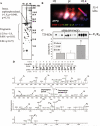Modulation of mitochondrial proteome and improved mitochondrial function by biventricular pacing of dyssynchronous failing hearts
- PMID: 20160199
- PMCID: PMC2921909
- DOI: 10.1161/CIRCGENETICS.109.871236
Modulation of mitochondrial proteome and improved mitochondrial function by biventricular pacing of dyssynchronous failing hearts
Abstract
Background: Cardiac resynchronization therapy (CRT) improves chamber mechanoenergetics and morbidity and mortality of patients manifesting heart failure with ventricular dyssynchrony; however, little is known about the molecular changes underlying CRT benefits. We hypothesized that mitochondria may play an important role because of their involvement in energy production.
Methods and results: Mitochondria isolated from the left ventricle in a canine model of dyssynchronous or resynchronized (CRT) heart failure were analyzed by a classical, gel-based, proteomic approach. Two-dimensional gel electrophoresis revealed that 31 mitochondrial proteins where changed when controlling the false discovery rate at 30%. Key enzymes in anaplerotic pathways, such as pyruvate carboxylation and branched-chain amino acid oxidation, were increased. These concerted changes, along with others, suggested that CRT may increase the pool of Krebs cycle intermediates and fuel oxidative phosphorylation. Nearly 50% of observed changes pertained to subunits of the respiratory chain. ATP synthase-beta subunit of complex V was less degraded, and its phosphorylation modulated by CRT was associated with increased formation (2-fold, P=0.004) and specific activity (+20%, P=0.05) of the mature complex. The importance of these modifications was supported by coordinated changes in mitochondrial chaperones and proteases. CRT increased the mitochondrial respiratory control index with tightened coupling when isolated mitochondria were reexposed to substrates for both complex I (glutamate and malate) and complex II (succinate), an effect likely related to ATP synthase subunit modifications and complex quantity and activity.
Conclusions: CRT potently affects both the mitochondrial proteome and the performance associated with improved cardiac function.
Figures





References
-
- Diwan A, Dorn GW., II Decompensation of cardiac hypertrophy: cellular mechanisms and novel therapeutic targets. Physiology (Bethesda) 2007;22:56–64. - PubMed
-
- Spragg DD, Kass DA. Pathobiology of left ventricular dyssynchrony and resynchronization. Prog Cardiovasc Dis. 2006;49:26–41. - PubMed
-
- Bax JJ, Abraham T, Barold SS, Breithardt OA, Fung JW, Garrigue S, Gorcsan J, III, Hayes DL, Kass DA, Knuuti J, Leclercq C, Linde C, Mark DB, Monaghan MJ, Nihoyannopoulos P, Schalij MJ, Stellbrink C, Yu CM. Cardiac resynchronization therapy: part 1—issues before device implantation. J Am Coll Cardiol. 2005;46:2153–2167. - PubMed
-
- Bilchick KC, Helm RH, Kass DA. Physiology of biventricular pacing. Curr Cardiol Rep. 2007;9:358–365. - PubMed
-
- Chakir K, Daya SK, Tunin RS, Helm RH, Byrne MJ, Dimaano VL, Lardo AC, Abraham TP, Tomaselli GF, Kass DA. Reversal of global apoptosis and regional stress kinase activation by cardiac resynchronization. Circulation. 2008;117:1369–1377. - PubMed
Publication types
MeSH terms
Substances
Grants and funding
LinkOut - more resources
Full Text Sources
Medical
Research Materials

